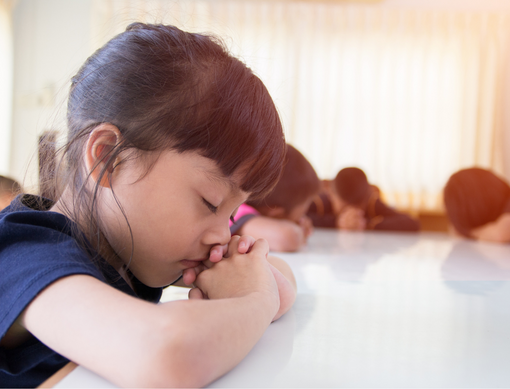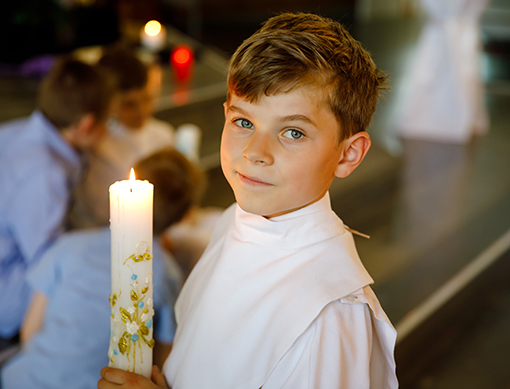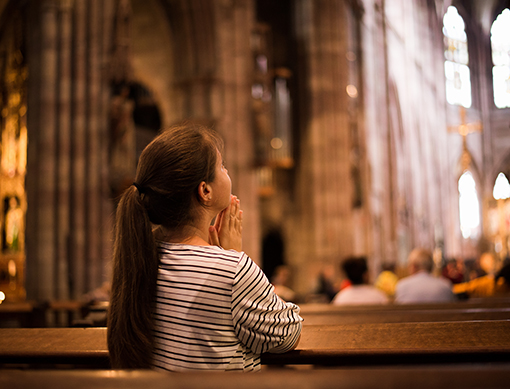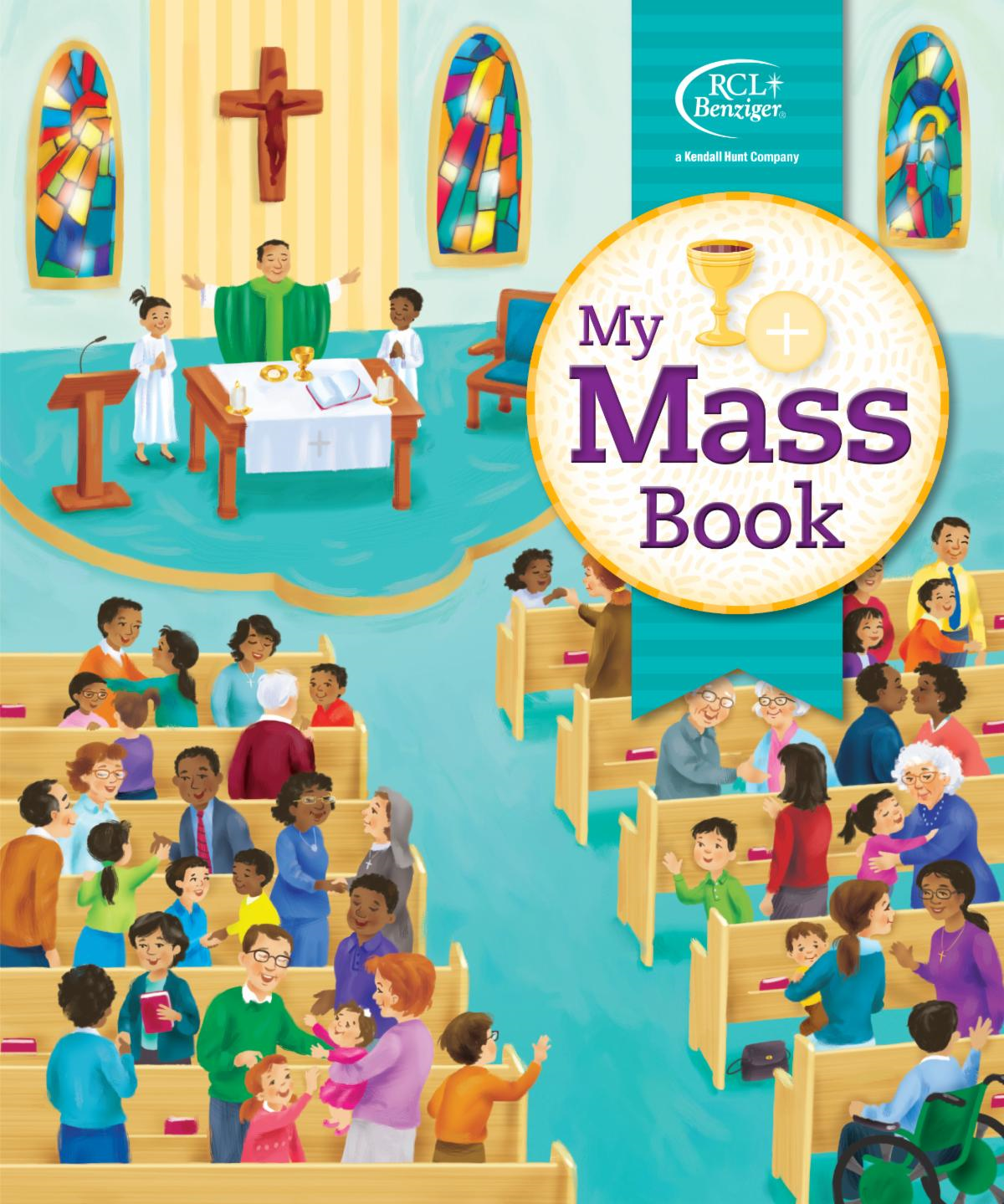The words “catechist” and “catechesis” have their roots in a Greek word that means “to sound” or to echo like whales and dolphins.” The Latin root of the word means "to charm, to fascinate, to teach orally, to instruct." Over time, catechesis came to mean “teaching by word of mouth” and implies dialoging and sharing our faith in an attractive way. As teachers of the Catholic faith, we are all catechists whose mission is to echo of the Word of God.
 The Catechism, reflected in your Blest Are We Faith in Action and Be My Disciples programs, provides the content for catechesis. We faithfully teach the content of the faith, employing all our skills and strategies to transmit information about the faith. Our mission as catechists calls us to go further. In On Catechesis in Our Time, St. John Paul II told us, “The definitive aim of catechesis is to put people not only in touch but in communion, in intimacy, with Jesus Christ” (5). And that won’t happen solely by learning information about Jesus. Everything we do as catechists – not only our lesson plans -- should help our students encounter the mystery of Christ.
The Catechism, reflected in your Blest Are We Faith in Action and Be My Disciples programs, provides the content for catechesis. We faithfully teach the content of the faith, employing all our skills and strategies to transmit information about the faith. Our mission as catechists calls us to go further. In On Catechesis in Our Time, St. John Paul II told us, “The definitive aim of catechesis is to put people not only in touch but in communion, in intimacy, with Jesus Christ” (5). And that won’t happen solely by learning information about Jesus. Everything we do as catechists – not only our lesson plans -- should help our students encounter the mystery of Christ.
Because the goal of catechesis is more than academic, the method differs, too. Both models need a leader who is competent, but the competency of the catechist begins with a willingness to demonstrate their faith in action and share their own faith journey. Your students need someone to help them have that encounter with Jesus. In the classroom, the Catholic catechist is the storyteller of the faith and a role model for young people. In the process, we also are learners who are growing closer to Christ.
How do we bring our students to an encounter with Jesus? Pope Francis gives us an answer: On the lips of the catechist the message must ring out over and over: “Jesus Christ loves you; he gave his life to save you; and now he is living at your side every day to enlighten, strengthen and free you.” (Joy of the Gospel, 164) He says, “What helps is to focus on the fundamental reality, which is the encounter with Christ, with his mercy and with his love, and to love our brothers and sisters as he has loved us” (October 14, 2013).
How Can We Grow as Catechists?
• Engage in personal prayer and spiritual growth practices, so as to have a living faith to share.
• Know the Scriptures and be able to share the story of salvation in your own words.
• Provide opportunities for encountering God: silence, meditation, use of imagination, journaling, and personal discernment.
• Form community in your classroom with prayer partners. For instance, draw names of prayer partners from a hat. Draw new prayer partners monthly.
• Illustrate faith concepts by sharing appropriate stories from your personal faith journey.
• Include the whole family in faith formation whenever possible.
 About the Author
About the AuthorDr. Lauri Przybysz specializes in equipping families to live their vocation to be domestic churches and signs of God’s love. Lauri received the Doctor of Ministry from the Catholic University of America, and she has been both a Catholic middle school religion teacher and a faith formation coordinator at the archdiocesan and parish levels. She is the mother of six children and grandmother of 21.
Recently, I was asked to write an article about Dr. Lena Frances Edwards, a Black American Catholic, prominent physician, humanitarian and philanthropist who was awarded the Presidential Medal of Freedom for her service to the poor and marginalized.
 What I discovered was that among all her awards, including 14 honorary degrees, the one she most valued was the Poverello Award from Franciscan University, because it was a symbol of the poverty embraced by St. Francis of Assisi, a saint she treasured and a vow she embraced her entire life – to help those in poverty.
What I discovered was that among all her awards, including 14 honorary degrees, the one she most valued was the Poverello Award from Franciscan University, because it was a symbol of the poverty embraced by St. Francis of Assisi, a saint she treasured and a vow she embraced her entire life – to help those in poverty.
In the face of obstacles brought about by her race and gender, Dr. Edwards, who became a Third Order Franciscan, found strength and hope in the Catholic faith she loved. She was a daily communicant and inspired those who knew her or were touched by her in some way.
At the same time I was writing that story, another story came my way that would include comments from elementary and middle students who shared, in their own words, the challenges and blessings of of religious education. What struck me was how much the faith element impacted them and how willing they were to share it.
Comments included, “[It has] made me more comfortable talking to God about the good and bad things going on in my life.” “Religion was new to me … but learning about God is so appealing to me. Now I know God is always with me and I can talk to him.” “Now I have a strong relationship with God and I call on him often.”
They talked about being happy to know all the words to so many prayers, to feel like they belong to a family, to know they are loved because God made them. They said, in so many ways, that they were happy to be Catholic. I thought it was such a wonderful reflection of their teachers.
How can we help students love being Catholic?
See and share the good everywhere – Children undoubtedly hear some, if not much, of the negativity about the Catholic Church, which, for many is translated to negativity about the Catholic faith. Find and discuss the good of our Catholic faith and the good works of the Church, the values and virtues of Catholics, the work that Catholics have done since the beginning of our country – schools, hospitals, service to the poor and those in need, which continues today. Include the very important teaching that every person is loved by God. Our children should be strengthened by their faith, and develop an assurance in the value of who they are because they are children of God.</p>
Talk about saints and our journey together – Most people know someone of whom others say, “She’s a saint.” It is the special loving and sacrificial qualities of those people that earn them that title. When the Catholic faith becomes a true part of who we are, our students included, it’s likely someone may one day say the same of us. In studying the saints, both ancient and new, students learn about what it means to live their faith and understand what it means to belong to the Communion of Saints. It’s a journey we all take together.
Use sacramentals as visual reminders – Symbols are very meaningful for children, especially when they are tangible, like the sacramentals of the Catholic faith which reflect our relationship with Jesus. Integrating holy water, crucifixes, icons, medals, blessed salt, and rosary beads help give students a rich experience of Catholic belief and tradition. Outward signs and actions like making the sign of the cross or blessings are also sacramentals which remind children to rely on God and, also, that they are part of a family of Catholics who believe and do the same things.
Share your own reason for hope – One of the greatest gifts of the Catholic faith is hope. In one of his general audiences, Pope Francis spoke about the important role hope plays in the Christian life: "Hope (is) that humble virtue which flows under the water of life, but that bears us up so we don't drown in so many difficulties, so we do not lose that desire to find God, to find that wonderful face which we will all see one day: hope." At a time, and in a culture, that is warped by violence and fear, our children are in need of the hope that faith in God can provide. Begin a conversation by sharing your own reasons for hope.
 About the Author
About the AuthorMary Clifford Morrell, mother of six and grandmother to ten, is a Catholic journalist, editor, and author who has served the Dioceses of Metuchen and Trenton, New Jersey; Burlington, Vermont, and RENEW International in the areas of religious education and communication.
Courage is a virtue, a habit of putting good values into practice. We aim to help children develop the strength to do or say what is right and good and to overcome fear, anxiety or any negative attitude that weakens one’s confidence to do and say what is right and good. This virtue is also called fortitude.
 Leading by example. Children look to us for examples of how they should act or behave. Although the time they spend in school is a fraction of the rest of their day, you have a prime opportunity to form courageous adults.
Leading by example. Children look to us for examples of how they should act or behave. Although the time they spend in school is a fraction of the rest of their day, you have a prime opportunity to form courageous adults.
Growing through knowledge. Having good information from reliable sources helps someone have the courage of their convictions. Good catechesis gives children reliable knowledge of our faith. Good education equips children to make wise decisions and stay safe.
Growing through experience. The greatest motivation for courage is love from people, such as their family and friends, who children can trust to stand up for them and help them to be the best they can be.
Meeting challenging life situations. In every lesson in every grade level of your Family Life series, children see opportunities to develop the knowledge, self-confidence, and assertiveness skills that they will need to recognize dangerous situations, avoid them if possible, and respond appropriately in time of need. Growing in courage helps children to be safe from abuse, but also helps them respond to other challenges that require them to decide to put their values into practice.
Classroom Applications
- Explain that it is OK to be afraid of some things and that it helps them to know what is safe and what is not.
- Name something that you are afraid of (without getting too personal). Start with a fun example: I am afraid of spiders. Ask students to help you think of steps you could take to become less afraid. Help them include key safety steps: Asking for help and recognizing potential dangers. In my spider example, the list would include: Learning how to identify spiders that are poisonous, planning to stay away from spiders, identifying a person you can trust to take care of the spider for you.
- Ask volunteers to name something they are afraid of. Ask the class to make helpful suggestions that include knowledge, planning, and identifying a trusted helper.
- Introduce other situations that require courage: Standing up for someone who is begin bullied; saying no to peer pressure; making a new friend.
- Scripture by heart. Remind them that God is always on their side. Invite students to commit one of these verses to memory:
- “Do not fear nor be dismayed, for the LORD, your God, is with you wherever you go.” - Joshua 1:9
- “Do not fear: I am with you; do not be anxious: I am your God. I will strengthen you.” - Isaiah 41:10
- “In the world you will have trouble, but take courage, I have conquered the world.” - John 16:33
 About the Author
About the AuthorDr. Lauri Przybysz specializes in equipping families to live their vocation to be domestic churches and signs of God’s love. Lauri received the Doctor of Ministry from the Catholic University of America, and she has been both a Catholic middle school religion teacher and a faith formation coordinator at the archdiocesan and parish levels. She is the mother of six children and grandmother of 21.
Product Highlight
Family Life Second Edition
Family Life Second Edition is the newly updated edition of RCL Benziger's leading K-8 supplemental program that addresses key concerns of today's Catholic families. Family Life includes child safety education in every grade level, promotes virtuous living, and strengthens Catholic identity.
The Family Life program reinforces the Catholic virtues and values that your students attain with their education. Family Life is essential to your school-based religious education program and meets Social and Emotional Learning (SEL) standards and benchmarks.
A catechism is the name given to a written work that contains an orderly summary of all the beliefs of the faith that is used as a teaching tool. The Catechism of the Catholic Church (CCC) was promulgated by John Paul II on October 11, 1992. In the Introduction, St. John Paul II explains why this new Catechism was published:
“…so that we can perceive that “Christ is always present in his Church, especially in the sacraments; he is the source of our faith, the model of Christian conduct and the Teacher of our prayer” (Fidei Depositum, #2).
 Roots of the Catechism. This catechism, which is only the second universal catechism written by the Church, was born out of the documents of Vatican II. It guards and presents more effectively the deposit of Christian doctrine, to make it more accessible to the Christian faithful and all people of goodwill in the contemporary world.
Roots of the Catechism. This catechism, which is only the second universal catechism written by the Church, was born out of the documents of Vatican II. It guards and presents more effectively the deposit of Christian doctrine, to make it more accessible to the Christian faithful and all people of goodwill in the contemporary world.
For American Catholics who grew up in the second half of the twentieth century, the word catechism meant the Baltimore Catechism, which originated at the Third Plenary Council of Baltimore in 1884 when the bishops of the United States decided to publish a national catechism. Many of us remember memorizing some of the 421 questions and answers in thirty-seven chapters.
The new Catechism expands on these same teachings, providing a deeper understanding of how our faith is based on the Bible and Catholic Tradition. It is organized into four pillars of Catholic teaching: the Creed, the Sacraments, the Commandments, and Prayer.
Using the Catechism in Lesson Planning. The Catechism Connection found on the Resources page in each unit of Blest Are We Faith in Action Teacher Edition supplies paragraph references to the CCC. Each paragraph of the CCC is numbered (in bold, to the left). Almost every paragraph is accompanied by cross-references that we can look up to see how one topic (like the Gifts of the Holy Spirit) can be found throughout the four pillars of our faith. You will notice, that the CCC references not just Sacred Scripture, but also the best of everything that’s been said on the topic by Councils, Popes, Saints and other holy writers in over 2000 years of Catholic tradition. The Index of Citations shows where a Bible verse is reflected in the Catechism. If you want to know more about a certain topic, look it up in the Index. The index refers to paragraph numbers, not page numbers. Handy summary statements on each topic are in the “In Brief” sections.
The Catechism’s text is found both in print and online. It is valuable to have your own print copy, so that you can highlight the passages that speak to you. A searchable flipbook version is available online: https://www.usccb.org/sites/default/files/flipbooks/catechism/index.html
Classroom Applications. Your students will encounter references to the CCC in their Blest Are We Faith in Action lessons. Explain that the CCC contains the reliable and orderly deposit of our faith. Point out the four pillars and the paragraph numbers. Guide older students in looking up a topic in the Index and then locating it in the text. Show how to look up vocabulary words in the CCC Glossary section.
 About the Author
About the AuthorDr. Lauri Przybysz specializes in equipping families to live their vocation to be domestic churches and signs of God’s love. Lauri received the Doctor of Ministry from the Catholic University of America, and she has been both a Catholic middle school religion teacher and a faith formation coordinator at the archdiocesan and parish levels. She is the mother of six children and grandmother of 21.
I really love Gospel music. It helps my faith come alive. One of my favorite Gospel hymns is “Take the Lord with You Everywhere You Go.” The refrain says:
You oughta take the Lord with you, children, everywhere you go.
You oughta take the Lord with you, children, everywhere you go.
You oughta take the Lord with you, everywhere you go,
In the streets, in the crowds, in your home, all alone, highways, byways, well, everywhere you go.

As we enter into a New Year, it’s the perfect time to remind students that with Jesus in their hearts, they take him wherever they go. Young students may not fully grasp the idea of Jesus in their hearts, as they take things more literally. For them, it’s important that they get to know Jesus, who he was, why he is so important to us as Catholics, and, for all students, the many ways in which we can take Jesus into the world with us.
As St. Theresa of Avila wrote, “Christ has no body now on earth but yours, no hands, no feet on earth but yours.”
Familiarize students with the love of Jesus through stories, music, and activities that bring love and joy to others. Engage them in conversations about how Jesus is connected to everything they experience in church and in prayer. Read more Gospel stories with the children this year and give children the opportunity to ask questions about what they heard or read. Allow them to wonder.
When we give students an experience of Jesus, the lessons about Jesus take on greater meaning. Take them to Mass, to Adoration, let them sit in silence and listen, observe the stained-glass windows of the church, the altar, the holy water, and the statues. Encourage them to draw not only what they saw, but what they felt.
God is always in relationship with our children. We just need to give them opportunities to recognize and express that relationship.
January 3 is also the Feast of the Holy Name of Jesus. We honor the name of Jesus because of the many blessings we have received through his birth. Consider reading Matthew 1:21 to the children, which is the Scripture verse in which the angel tells Joseph that he and Mary should name the child Jesus. Let children talk about their own names. Were they named after someone in their family, or a saint perhaps, or does their name means something special?
Point out that Jesus’ name means savior, and he was born to save us from the many wrong choices we might make that would separate us from God – who loves us dearly as his children and wants to always be in a relationship with us.
As a classroom resolution this year, encourage children to use the name of Jesus:
With respect – When God created the 10 Commandments God wrote, “Do not take the Lord’s name in vain.” That means to use God’s name only with respect; to never use God’s name in anger or to disrespect someone else. That commandment applies to Jesus’ name, as well, since Jesus is God.
Students will also learn that respect, including respect for someone’s name, should be part of all meaningful relationships.
To pray – The name of Jesus has been whispered and recited in prayer since ancient times. Give students the opportunity to pray with Jesus’ name in class and encourage them to recite very brief Jesus prayers in their minds whenever they feel the need for support: Jesus, help me. Jesus, give me courage. Jesus, take away my fear. Jesus, help me do the right thing. Jesus, forgive me. Children may want to create their own prayer to Jesus that they can pray whenever they want to.
As a reminder God loves them – The most important lesson of Jesus is that God loved us enough to become incarnate in a tiny baby, to grow up, teach, heal, suffer, die and be resurrected so we would learn what God was really like, love God and serve God, because God loved us first.
One more Gospel song for the road – “Take Jesus With You.” The refrain reminds me of why I pray Jesus’ name so often; to lead me, guide me, protect me and direct me:
Take Jesus with you,
Everywhere you go.
You oughta take Jesus with you,
Everywhere you go.
He will lead you,
Guide you,
Protect and direct you,
He will keep you from doing things wrong.
 About the Author
About the AuthorMary Clifford Morrell, mother of six and grandmother to ten, is a Catholic journalist, editor, and author who has served the Dioceses of Metuchen and Trenton, New Jersey; Burlington, Vermont, and RENEW International in the areas of religious education and communication.
Your faith formation sessions can prepare students to celebrate Mass more joyfully and fruitfully. Here are some activities to help children prepare to be more fully present in liturgy by engaging their heads, hearts, hands, and voices.
 Get ready to sing. Practice standard hymns in class. Identify hymns that are commonly used at church. Ask students to recall some hymns they know. Invite your parish music minister to visit your class and teach them a new hymn.
Get ready to sing. Practice standard hymns in class. Identify hymns that are commonly used at church. Ask students to recall some hymns they know. Invite your parish music minister to visit your class and teach them a new hymn.
Preview the Scripture readings. Catholics all over the world are hearing the same readings—we are united in faith in a visible way. You will find reflections on the Readings throughout the year in the Praying the Scriptures lectionary resources.
Visit your parish church – in person or virtually. Have students draw a diagram of the inside of their parish church from memory. Help them include the altar, ambo, cantor stand, choir seats, statues, organ or piano. Point out that the majority of the space is filled with seats for a good reason: We, the people gathered, are Church.
Learn more about worship. The second chapter of each unit of Blest Are We Faith in Action is based on the worship pillar of the Catechism of the Catholic Church. Invite students to locate the Worship chapters in their student text. Invite volunteers to name some of the chapter titles. The “Hear and Believe” portion of the second chapter of each unit focuses on Worship. Ask volunteers to name some of the focuses.
Liturgical Celebrations throughout the Year. The “Feasts and Seasons” lessons of each grade level of Blest Are We Faith in Action highlight the liturgical seasons. Ask students to recall the color of the priest’s vestments at a recent Mass. Ask students: What mood or emotion do you feel when you see the colors at church? Additional Liturgical Year lessons and activities are available on your Flourish account.
After Mass. At the final blessing, we are sent out! “Go, and proclaim the Good News!” We never leave the Gospel behind in church. We take it with us. We never leave the community behind. We leave with them. We also take the fruits of this Eucharist, which we have faithfully celebrated in memory of Jesus. Ask students: What can you do to be a witness to Jesus?
Reflecting on the Mass. Invite students to describe their experience of Mass, either in words or by drawing pictures:
- Recall how you used your five senses: what you saw; what you heard; what you touched; what you tasted; and/or what you smelled.
- What do you most remember from the Sunday readings and homily?
- How will you keep the message you heard at the heart of your life this week? What is one way you can put it into practice in your daily life?
 About the Author
About the AuthorDr. Lauri Przybysz specializes in equipping families to live their vocation to be domestic churches and signs of God’s love. Lauri received the Doctor of Ministry from the Catholic University of America, and she has been both a Catholic middle school religion teacher and a faith formation coordinator at the archdiocesan and parish levels. She is the mother of six children and grandmother of 21.
The annual Week of Prayer for Christian Unity is a response to Christ's prayer “that they all may be one" (John 17:21). It is an eight-day period of prayer in which all Christians are invited to participate. The week is celebrated each year from January 18-25, concluding on the Feast of the Conversion of St. Paul. Praying together for Christian unity allows us to reflect on what unites us and commit ourselves to confront oppression and division amongst humanity. We ask God to teach us how to love one another as Christ loved us and help us to show one another the unusual kindness that can only come from knowing his Son, Jesus.
 It is likely that some of the families of your students are interchurch, two baptized Christians who have chosen to raise their children in the Catholic Church and send them to your school. You may also have students who have only one Christian parent who may or may not be a Catholic. They have chosen to partner with you and your Catholic school in this endeavor. We are glad to help them in their important task. We can help them focus on what our faith traditions have in common.
It is likely that some of the families of your students are interchurch, two baptized Christians who have chosen to raise their children in the Catholic Church and send them to your school. You may also have students who have only one Christian parent who may or may not be a Catholic. They have chosen to partner with you and your Catholic school in this endeavor. We are glad to help them in their important task. We can help them focus on what our faith traditions have in common.
United in Service. Families can express their common faith in action. In many parts of the country, churches work together to feed the hungry, help immigrants, aid those who are incapacitated and perform other works of mercy. Often, we get to know other Christians by sharing the work involved in caring for those in need. Through our common commitment to Christ, we often come to a deeper understanding of one another. All are called to do their part in making Christ’s love, joy and compassion present as they go about their lives together.
Sharing the Scriptures. Whenever we focus on learning about the Bible, we help interchurch families have a common language of faith. At each level of Blest Are We Faith in Action, there is an introductory lesson on the Bible that helps young people develop an understanding and appreciation for the Word of God.
Care for our Common Home. Christians from every tradition, indeed all people of good will, can come together to work for the environment. Unite the hearts of your students around this theme. Download “Helping Kids Care for Creation” activities and a prayer service from the free Catholic Resources.
Together for Good. Each year, a different theme is chosen for the Week of Prayer for Christian Unity. The theme for 2023 is "Do good; seek justice" (Isaiah 1:17). Consult your Flourish account and Blest Are We Faith in Action index for activities related to justice and the common good.
Family Time for at Home and in Community. The Family Life series, at every level, features lessons about living together in peace and unity. Use these lessons as part of your Week of Christian Unity planning.
 About the Author
About the AuthorDr. Lauri Przybysz specializes in equipping families to live their vocation to be domestic churches and signs of God’s love. Lauri received the Doctor of Ministry from the Catholic University of America, and she has been both a Catholic middle school religion teacher and a faith formation coordinator at the archdiocesan and parish levels. She is the mother of six children and grandmother of 21.
Product Highlight
Family Life Second Edition
Family Life Second Edition is the newly updated edition of RCL Benziger's leading K-8 supplemental program that addresses key concerns of today's Catholic families. Family Life includes child safety education in every grade level, promotes virtuous living, and strengthens Catholic identity.
The Family Life program reinforces the Catholic virtues and values that your students attain with their education. Family Life is essential to your school-based religious education program and meets Social and Emotional Learning (SEL) standards and benchmarks.
On the day that I graduate from college with my bachelor’s degree, my dad graduated from high school with his GED.
I don’t know who he was proudest of, me or himself.
 My dad was one of many who missed out on school during the Great Depression because they were forced to go to work to help support the family. For my dad, that happened when he was in eighth grade. His dad had died a few years earlier and all his brothers were much older and had moved out of the house. It was him and his mom and times were very tough.
My dad was one of many who missed out on school during the Great Depression because they were forced to go to work to help support the family. For my dad, that happened when he was in eighth grade. His dad had died a few years earlier and all his brothers were much older and had moved out of the house. It was him and his mom and times were very tough.
As I grew up, my dad, who was exceptionally intelligent and self-educated, often talked about the blessing of education and the gift of knowledge.
Fortunately, most of our children have not been deprived of either, but there are many across the country and around the world who are. I think we give our children a gift when we help them understand that our ability and opportunity to learn is a blessing that shouldn’t be taken for granted.
And surely, our ability to learn and to make wise choices with our knowledge is a gift from God. Scripture teaches us about the gift of knowledge and the value of learning. Psalm 18:15 reminds us, “The mind of the discerning acquires knowledge, and the ear of the wise seeks knowledge.”
Students will learn about the Seven Gifts of the Holy Spirit at some point during their religion classes, so they will learn that three of those gifts are Wisdom, Understanding and Knowledge. The tendency is often to memorize the list but never enter into any in-depth discussion about what the three are, how they are different from each other and how they are connected.
As Catholics, we believe in God as relational, being in a relationship with each of his children. To help us live in relationship with God and with our brothers and sisters God instills in us a need to learn, a need for wisdom to make good, godly judgements based on our understanding of the knowledge we have gained during our lifetimes.
How can we encourage our children and youth to value these gifts of God?
Provide opportunities for students to demonstrate something they have learned, whether it was in a class or on their own. Ask them to share the different ways in which they learn. Undoubtedly, they will talk about social media, but encourage them to think about reading, investigating with microscopes or telescopes, or what they’ve learned from adults who share their knowledge.
Share your knowledge with your studentsTeachers often get caught up in the lesson plan and forget that they own a wealth of knowledge on things outside of the class material. Enthusiasm about knowledge is contagious and makes teachers excellent role models for students. Do you garden, play chess, play an instrument, bake, do calligraphy, build models”? The list is endless, but each one of these specialties are more than just a hobby. They require a unique knowledge that can be shared.
Gather motivational stories about people whose lives were changed by knowledge. Fellow teachers or school staff may have stories to share or check with the school or local librarian for age-appropriate books. One story that comes to mind is that of Helen Keller, who lost both her sight and her hearing as a baby. She became a prolific author and the first deaf and blind person to earn a Bachelor of Arts degree. She said, “Knowledge is happiness, because to have knowledge – broad, deep knowledge – Is to know true ends from false, and lofty things from low.”
Helen also had a great love for God, who she said, “is very near each one of us.” Helen shared her feelings that “It is so pleasant to learn about new things. Every day I find how little I know, but I do not feel discouraged since God has given me an eternity in which to learn more.”
Ask questions on a regular basis. At the end of every day, ask a few students, “What’s one thing you learned today?” When students come back to school after the weekend, or a vacation, ask, “What did you learn while you were away?” The repetitive question encourages students’ understanding that learning new things can happen anywhere at any time, and is something worthy of sharing.
Talk about knowledge as a gift from God.Scripture is full of teaching about the source of wisdom, understanding and knowledge. Here are a few quotes:
- Proverbs 2:6 – For the Lord gives wisdom, from his mouth come knowledge and understanding.
- Isaiah 11:2 – The Spirit of the Lord will rest on him— the Spirit of wisdom and of understanding, the Spirit of counsel and of might, the Spirit of the knowledge and fear of the Lord.
- Psalms 119:66 – Teach me wisdom and knowledge, for in your commandments I trust.
For teacher reflection: "The gift of knowledge puts us in tune with God's gaze on things and on people. …Through this spiritual gift, we are enabled to see every person, and the world around us, in the light of God's loving plan." ~ Pope Francis
 About the Author
About the AuthorMary Clifford Morrell, mother of six and grandmother to ten, is a Catholic journalist, editor, and author who has served the Dioceses of Metuchen and Trenton, New Jersey; Burlington, Vermont, and RENEW International in the areas of religious education and communication.
During the Christmas season, we are excited to receive and gift presents to our loved ones and teachers. The best presents reflect the personality and taste of the giver. Givers of presents are putting a bit of themselves in the gift box. When I get an original work of art from one of my grandchildren, that is a treasure that came straight from their heart to mine. These kinds of presents remind me of the person who gave the gift to me. When I see or wear of use that gift, I feel their presence in my heart, and I am grateful for them. Receiving a present from those we love calls us to do something in return. We want to give them a gift, too. At one time or another, we have all been surprised by a gift and embarrassed that we did not have a gift to give.
 In the gift of the Eucharist, Jesus is truly present in the form of bread and wine. He himself is the gift! When we receive the gift to the Eucharist, we want to be well prepared to reciprocate to Jesus. Bread and wine are transformed into the body and blood of Christ. Our response to the gift of the Eucharist is gratitude, and indeed the word Eucharist means “thanksgiving.” In sacramental form, Jesus remains really present to us.
In the gift of the Eucharist, Jesus is truly present in the form of bread and wine. He himself is the gift! When we receive the gift to the Eucharist, we want to be well prepared to reciprocate to Jesus. Bread and wine are transformed into the body and blood of Christ. Our response to the gift of the Eucharist is gratitude, and indeed the word Eucharist means “thanksgiving.” In sacramental form, Jesus remains really present to us.
Classroom Discussion: “More Than Showing Up for Mass”: One important question remains: Are we present to Jesus at Mass? First, ask children to share a memory of receiving a gift they really liked. Who gave them the gift. Why was that gift extra special to them? What did they say when they opened the gift? What did they do? How did they show their appreciation? After all the students have told their stories, speak of how we can participate when we receive Jesus in the Eucharist. With the class, make a list of ways to demonstrate that we are present to Jesus at Mass. Examples: Go to Mass every week, pay attention to the Liturgy, have a positive attitude about Mass, really listen to the Scripture readings and homily, follow the missalette, join in the prayers and responses, sing, offer the sign of peace to family and neighbors, receive Jesus in Holy Communion, pray for all the people in the church.
A Story of Jesus’ Presence. Being at Mass with our family and friends, we are in Jesus’ presence, too. Read or retell the story of Jesus appearing to the disciples after his Resurrection on the road to Emmaus from the Gospel of Luke 24: 12-35. Scripture videos available in your Flourish subscription associated with Blest Are We Faith in Action in both Grade 5, Unit 3, and Grade 8, Unit 1. When we spend time together, talking and listening to each other, enjoying good food and good company, Jesus is there with us. He has given us the Greatest Present: His Presence.
 About the Author
About the AuthorDr. Lauri Przybysz specializes in equipping families to live their vocation to be domestic churches and signs of God’s love. Lauri received the Doctor of Ministry from the Catholic University of America, and she has been both a Catholic middle school religion teacher and a faith formation coordinator at the archdiocesan and parish levels. She is the mother of six children and grandmother of 21.
Product Recommendation
My Mass Book
Recommended for children ages 6-9, this colorfully-illustrated and portable book helps children pray with the whole family of God at Mass and with their families in the Church of the home. It includes The Order of Mass, its prayers and responses, Catholic Prayers and Practices, including a visit to the church, symbols of the Church, the liturgical year, an examination of conscience, the Rosary, the Stations of the Cross, and other traditional Catholic prayers.
During Advent, though we are preparing for our Lord’s birth, it is easy for us and our children to be pulled away from a time of reflection and prayer by the Christmas of decorations and presents. Children, especially, are understandably excited about the prospect of opening gifts under the tree on Christmas morning.
 It’s not surprising that a focus on the reason for the season, the Incarnation, gets lost. There is, however, an easy and enjoyable way to reinforce the true the meaning of Christmas even with the youngest of children.
It’s not surprising that a focus on the reason for the season, the Incarnation, gets lost. There is, however, an easy and enjoyable way to reinforce the true the meaning of Christmas even with the youngest of children.
It has to do with stories, Christmas stories.
"As we contemplate the Christmas story,” said Pope Francis, “we are invited to set out on a spiritual journey, drawn by the humility of the God who became man in order to encounter every man and woman. We come to realize that so great is his love for us that he became one of us, so that we in turn might become one with him.”
At the heart of every Christmas story, especially those that are a retelling of the Nativity, is the story of the Incarnation when God took on human flesh in the form of Jesus solely out of love for us.
The power of the written word to influence an understanding of Christmas is well-documented and is an opportunity Catholic families, teachers and catechists can embrace by engaging their children and students in holiday reading.
Establishing a tradition of reading together during Advent and Christmas provides time for questions and conversations about the meaning of Christmas, about waiting for the Lord with an open heart, about the Nativity and Incarnation, about giving and not just receiving.
Christmas stories read with or to students is an effective and enjoyable supplement to text book lessons. If your school library or your classroom book corner doesn’t offer a broad enough selection, try your local library, or ask parents to send in their families favorite Christmas books to share with the class. Just be sure those books make it home!
Some Christmas Favorites for Holiday Reading
“Advent Storybook: 24 Stories to Share Before Christmas” by Antonie Schneider and Maja Dusikovaa, illustrator, is the story of Benjamin Bear who cannot wait for Christmas to come, so his mother tells him that every day when he opens a door on his Advent calendar, she'll tell him a story about another little bear and his long journey to Bethlehem to see the Christ Child.
“The Gift of the Magi” by O. Henry and P.J. Lynch, illustrator, is a classic tale of love and sacrifice as the most meaningful of Christmas gifts.
“Joy to the World” by Tomie dePaola is a favorite Christmas collection which includes the well-loved stories of The Night of Las Posadas, The Story of the Three Wise Kings, and The Legend of the Poinsettia.
“The Donkey’s Tales: The Story of Jesus” by Adele Colvin and Peyton Carmichael, is a story about a grandmother donkey who carried Mary to Bethlehem and the donkey’s grandson who carried Jesus into Jerusalem on the first Palm Sunday.
“The Christmas Miracle of Jonathan Toomey” by Susan Wojciechowski and P.J. Lynch, illustrator, is a touching story about a widow and her son who ask reclusive woodcarver Jonathan Toomey to carve a Nativity scene for them in time for Christmas. What happens is a hopeful, joyful Christmas miracle.
“Christmas in a Manger” by Nola Buck and illustrator Felicia Bond is a much-loved telling of the beautiful first Christmas story in a board book for young children.
“Amazing Peace: A Christmas Poem” by Maya Angelou and illustrators Steve Johnson and Lou Fancher, inspires readers to embrace the peace and promise of Christmas in a poem about a family that joins with their very diversified community to celebrate the holidays.
“The Peace of Christmas: Quiet Reflections with Pope Francis,” published by Franciscan Media, offers adults the opportunity to reflect on the Incarnation as a reality of Catholic faith.
In all our lessons about the Incarnation, during this time when children and adults are focused on gifts, it’s helpful to remember Pope Francis’ description of the Incarnation as the “original gift of Christmas.”
The Holy Father explains, "On that holy night, God becoming flesh, wanting to become a gift for man, gave himself for us; God has made his only-begotten Son a gift for us, taking our humanity to give us his divinity. Here we find the model of our giving, because our relationships, especially the most important ones, are driven by the free gift of love."
 About the Author
About the AuthorMary Clifford Morrell, mother of six and grandmother to ten, is a Catholic journalist, editor, and author who has served the Dioceses of Metuchen and Trenton, New Jersey; Burlington, Vermont, and RENEW International in the areas of religious education and communication.
Pagination
Latest
Categories
Archives
- February 2015 (2)
- March 2015 (2)
- April 2015 (5)
- May 2015 (3)
- June 2015 (6)
- July 2015 (3)
- August 2015 (5)
- September 2015 (5)
- October 2015 (4)
- November 2015 (2)
- December 2015 (1)
- February 2016 (2)
- March 2016 (1)
- April 2016 (2)
- May 2016 (2)
- July 2016 (2)
- August 2016 (2)
- September 2016 (1)
- October 2016 (5)
- November 2016 (1)
- December 2016 (3)
- January 2017 (2)
- February 2017 (3)
- March 2017 (2)
- April 2017 (1)
- June 2017 (2)
- July 2017 (2)
- August 2017 (1)
- April 2018 (1)
- October 2018 (2)
- December 2018 (2)
- February 2019 (3)
- March 2019 (2)
- April 2019 (2)
- May 2019 (3)
- June 2019 (1)
- July 2019 (16)
- August 2019 (8)
- March 2020 (4)
- April 2020 (6)
- May 2020 (8)
- June 2020 (7)
- July 2020 (5)
- August 2020 (7)
- September 2020 (4)
- October 2020 (5)
- November 2020 (9)
- December 2020 (11)
- January 2021 (10)
- February 2021 (8)
- March 2021 (5)
- April 2021 (4)
- May 2021 (4)
- June 2021 (5)
- July 2021 (2)
- August 2021 (3)
- September 2021 (4)
- October 2021 (4)
- November 2021 (2)
- December 2021 (5)
- January 2022 (4)
- February 2022 (4)
- March 2022 (9)
- April 2022 (7)
- May 2022 (9)
- June 2022 (12)
- July 2022 (7)
- August 2022 (10)
- September 2022 (9)
- October 2022 (11)
- November 2022 (8)
- December 2022 (7)
- January 2023 (2)
- February 2023 (10)
- March 2023 (9)
- April 2023 (10)
- May 2023 (8)
- June 2023 (4)
- July 2023 (3)
- August 2023 (2)
